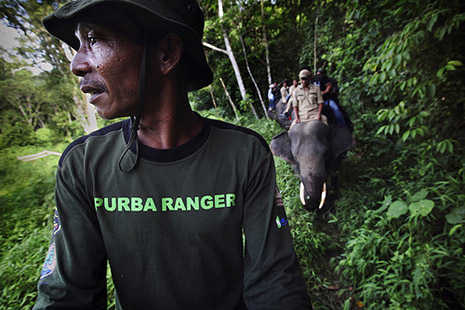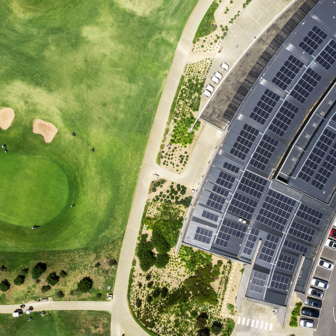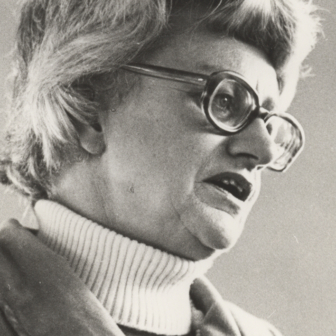“WE WANT to avoid business as usual,” says Ilarius Wibisono. From the thirty-year insurgency to the Boxing Day tsunami to a frenetic reconstruction, not much of the recent past in Indonesia’s Aceh province could be described as “business as usual.” But Wibisono, an adviser on sustainability to the province’s governor, is talking about the sort of status quo that results in greenhouse gases being pumped into the atmosphere in ever-increasing volumes.
Sitting in the lobby of Banda Aceh’s Hermes hotel, Wibisono speaks over a din of background music and conversation. It’s late on a weeknight but the place is packed with people drinking tea and coffee (but no alcohol – Sharia law is enforced here), talking and smoking. Government officials in green uniforms linger from the day’s healthcare reform meeting. The odd local politician moves from table to table. The air hangs thick with smoke and agendas, all of which marks Hermes out as the Rick’s of Banda Aceh – the sort of place where everyone goes, or winds up.
Just a smattering of foreigners remains. One arrives in a white UN car of the type once ubiquitous here. A middle-aged European stays just long enough to pick up some pastries from the lobby cafe. Others who might be officials, aid workers or investors talk in small huddles with local contacts or among themselves – the usual suspects of international travel, veterans of a hundred hotel lobbies. Ultimately, though, it’s the locals who are now in charge of developing Aceh. And Ilarius Wibisono reckons a plan to use carbon trading to protect Aceh’s forests will help to do just that.
The consequences of deforestation are as stark as the landscapes it leaves behind: vast swathes of wasteland; whole ecosystems destroyed; tigers and orangutans deprived of homes and threatened with extinction. Above all, it hastens global warming. According to the Intergovernmental Panel on Climate Change, deforestation is responsible for 17 per cent of the world’s annual greenhouse gas emissions. In Indonesia, land use, land use change and forestry is estimated to account for a massive 85 per cent of greenhouse gas emissions, making Indonesia one of the world’s largest sources of climate pollution.
As the world’s leaders have cast about for an effective response to climate change, carbon trading has come increasingly to the fore as a means to lower emissions. Whether it’s the compulsory EU Emission Trading System or voluntary markets like the Chicago Climate Exchange, the principle is the same: credits generated by reduced emissions can be purchased by others to offset their own emissions over a specified cap, or to sell on.
Now there is pressure to deal forests into the carbon markets, by allowing projects that avoid deforestation to generate tradable credits. The Bali Road Map, agreed at UN climate negotiations in 2007, encouraged the development of measures to reduce emissions from deforestation and forest degradation. This strategy – the UN Collaborative Programme on Reducing Emissions from Deforestation and Forest Degradation in Developing Countries – is usually known as REDD. Last December’s Copenhagen Accord endorsed the concept of REDD+, which expands the program to include measures that enhance forest stocks. The Accord called on rich nations to provide “substantial finance” to developing countries for REDD projects. This “fast-start” financing period is generally seen as a bridge to a more economically sustainable model under which forest-generated credits would be included in carbon markets.
An early test of the REDD concept is underway in Indonesia’s tropical Aceh province. It’s a challenging context: an estimated 170,000 of the province’s residents were killed by the 2004 Boxing Day tsunami, and whole communities were wiped out. The province has been rebuilding ever since, aided by billions in foreign donations. And Aceh is also dealing with a legacy of conflict: a thirty-year struggle between an independence movement and the Indonesian state ended only in the wake of the tsunami, with the signing of a provincial autonomy deal.
As tragic as it has been, the upheaval of Aceh’s recent past has created its own opportunities. The massive injection of foreign aid provided funds and expertise for forest protection. The demobilisation of insurgents and high unemployment make the prospect of REDD jobs and REDD funds attractive. And the conflict kept the rate of logging down, meaning there are still forests in Aceh to protect.
In 2008 the province’s first popularly elected governor, Irwandi Yusuf, announced a policy framework for sustainability – the Green Economic Development and Investment Strategy for Aceh, or “Aceh Green.” Sustainable land use, forest protection and reforestation feature prominently in the framework; “major new investments and financing from a variety of sources” is a specified goal.
Wibisono, the governor’s adviser, describes Aceh Green as a framework for integrating “environmental, social and peace concerns into the whole developmental agenda.” According to Wibisono, one of the Aceh Green secretariat’s roles has been to balance the different interests of the players involved – profit-seeking firms, NGOs seeking environmental protection, local communities seeking a livelihood – and “ensure that they are making progress together.”
Aceh Green is part of Governor Irwandi’s strategy for building a post-disaster, post-conflict economy. Finding work for demobilised combatants is the immediate challenge, but the larger goal is to encourage whole communities to stop deforestation and rely on less destructive ways of earning a living.
REDD, which Irwandi promoted at the 2007 UN climate conference in Bali, was identified as a means to this end. First, protect the forests, then measure the benefits, then generate carbon credits with which to fund local communities. The linear progression of a REDD project makes its attractions clear, but also gives rise to significant risk. If the right standards are not satisfied at each stage – consent from affected communities, verification of improvements on the business-as-usual baseline – no carbon credits are generated and there’s no payoff for anyone. No wonder, then, that a foreign project officer describes the Aceh Green team as “massively overworked. They are so committed to what they are trying to achieve, but there are a lot of capacity weaknesses.”
A big test for the team is the world’s first commercially funded REDD project in the forests of Ulu Masen. The project is a collaboration between the Aceh government, Carbon Conservation (the firm that brokered the deal), Merrill Lynch (which provides funding in return for a share of the expected carbon credits) and Fauna & Flora International (the NGO running the protection activities). Former insurgents, loggers and poachers have been trained as rangers and charged with monitoring the forests for illegal logging. The Aceh government gave ex-combatants portions of land but they often had no idea how to farm, so farming techniques are being taught. Nurseries have been encouraged to diversify local incomes, and rangers have been posted to look out for marauding elephants, which can devastate communities’ crops.
The project is slated to last for thirty years, but its ability to protect significant amounts of forest and generate the carbon credits to sustain that protection should become clear far sooner.
The next step is likely to be a REDD project in the Leuser ecosystem, the vast tract of forests south of Ulu Masen. Together, the protection programs in Leuser and Ulu Masen constitute the World Bank–overseen Aceh Forest and Environment Project, which has been one component of the tsunami recovery effort. The project – originally due to end in June – has been extended into 2011 while leftover funds are spent.
In Leuser, the Leuser International Foundation has been training local forest rangers to use maps and GPS to accurately record forest damage. Some are trained in law enforcement. The foundation uses satellite images to monitor deforestation, advises government on responses and provides information to public meetings and the local media.
G.V. Reddy, the foundation’s ecosystem manager, told me that the Ulu Masen project is at “an experimental stage – there is a lot of enthusiasm.” According to Reddy, a model for REDD projects has emerged in Aceh. It has been shaped by the extraordinary local circumstances: the tsunami, the recovery effort and the resulting forest protection project – “the right kind of project at the right time,” according to this veteran forest manager. He is adamant that the forests in Leuser “have a future only in the carbon projects.” If a REDD deal can be put together, says Reddy, “the ecosystem will survive” and “the community will get at least some money.” And if the community sees that direct benefit, they might then stop cutting down the trees.
Yakob Ishadamy, who heads the Aceh Green secretariat, stresses that Leuser is not only much bigger than Ulu Masen, it is home to “incomparable” biodiversity. Global Eco Rescue, a project management firm, is currently designing a REDD project for Leuser under the Aceh Green framework and in partnership with local firms. According to Global Eco Rescue, one such firm – Mitra Koalisi – has been in contact with villages across the ecosystem to gauge approaches to community consultation, benefit-sharing and dispute resolution.
ACEH’s government, meanwhile, has wider ambitions for REDD revenue. In May Aceh hosted the Governors’ Climate and Forests Taskforce, a meeting of subnational governments championed by California governor Arnold Schwarzenegger. Ilarius Wibisono says the taskforce can “encourage international negotiations to come to the final deal.” Even in the absence of such a deal, he has high hopes that the taskforce can develop into a fledgling market for carbon credits, bringing together supply – Indonesia and Brazil – and demand – US states and also, Wibisono hopes, Canadian provinces.
Jane Dunlop, Fauna & Flora International’s REDD team manager in Aceh, describes the taskforce as crucial. “It’s a very open process and it’s a process where states such as Aceh have a real say in contributing to what [states] like California might be developing.” Dunlop says that the taskforce could indeed form the basis of a market while the world waits for a UN deal. This makes it “a real opportunity for a province like Aceh to contribute to international developments on climate change and REDD.”
International developments thus far have been characteristically fitful. From 29 November the world’s governments will meet in Cancun for the annual climate change summit. After the disappointment of Copenhagen, expectations are low. Zulkifli Hasan, Indonesia’s forestry minister, has predicted that “there will be no agreements on REDD reached in this year’s meeting.” He compared the UN talks to World Trade Organization rounds, “which fell apart several times,” and stressed the “need to increase our voluntary deals” on REDD.
Hasan’s focus on voluntary deals is understandable. At the moment, that’s where the money is. In May, fifty-eight nations met in Oslo under the banner of the REDD+ Partnership. A minimum of US$4 billion by 2012 was pledged for REDD projects in developing countries.
So it is not surprising that for Indonesia, with a reported forty-five REDD projects at various stages of development, voluntary carbon markets are where the action is. By far the biggest voluntary financing deal Indonesia has struck is with Norway. At the Oslo meeting in May, Norway pledged US$1 billion to support REDD projects in Indonesia. This is foreign aid rather than a component of Norway’s own emissions mitigation effort, and the government in Oslo isn’t expecting carbon credits in return.
The Norway–Indonesia deal was presented to other nations and UN agencies on the fringes of the UN General Assembly meeting in New York last month. With financier George Soros, US climate envoy Todd Stern and Australian foreign minister Kevin Rudd looking on, Indonesia confirmed that a national REDD taskforce would be established to drive government strategy on the issue.
Although the agreement between Norway and Indonesia did not include Aceh, one source I spoke to suspects that bringing Aceh into the deal, given the progress of the Ulu Masen project, will have been canvassed in recent negotiations between the two countries. Ilarius Wibisono says the Aceh government would be “more than happy” to be part of the Norway deal.
Norway has previously committed US$1 billion to Brazil, payable if that country meets deforestation reduction targets. Norway’s prime minister, Jens Stoltenberg, explains the thinking: “To reduce deforestation is the way we can achieve the quickest, the biggest and the cheapest reductions [in emissions]. That’s why Norway is pushing so much forward and is so active.”
WHATEVER its merits, the fact that movement on REDD is happening outside the UN negotiations underscores the lack of consensus on the model in the international community. Among environmentalists and affected communities, REDD remains intensely controversial. There are vocal critics of individual projects, of the REDD+ Partnership negotiations and of the concept of trading forest credits itself.
At the Governors’ Climate and Forests Taskforce in May, a group calling itself the Civil Society Forum for the Sovereignty of Mukim protested against what it called “the hype marketing of Aceh as [a] REDD designated area.” (A mukim is a traditional jurisdiction in Ulu Masen.) The group complained that “basic information about forest and climate projects is barely available for the affected local people.” It pledged to reject any REDD proposal until “indigenous community rights to land and management of natural resources and other property” are recognised.
Some observers have raised doubts about whether the protesters were from areas affected by the Ulu Masen REDD project. Nevertheless, there are many other critics. Friends of the Earth Indonesia – known by its local acronym, WALHI – has flagged “a number of potentially problematic issues” with the Ulu Masen project, including concerns about “transparency” and “adequate representation of local communities,” and has called for the project to be monitored closely. WALHI “rejects REDD in its current guise” and raises the spectre of “indigenous and forest dependent peoples” being barred from the forests that are their home. According to the organisation, it is “vital that greater recognition of indigenous and forest dependent communities’ land tenure and improving forest governance form central components of future REDD negotiations.”
Chris Lang, who runs the REDD-Monitor website from Jakarta, maintains that “trading carbon stored in forests without meaningful emissions reductions in the North isn’t going to address climate change.” His concern is that a trade in forest credits would become a loophole in the emissions reductions commitments of developed countries. REDD, he says, is “being sold as an easy solution to a very complex problem.”
In Indonesia, as in Brazil and elsewhere, it is a game of trial and error played with a diminishing resource against a ticking clock. Some corners may be cut. David Ritter, head of biodiversity campaigns for Greenpeace UK, is broadly supportive of the interim REDD+ Partnership but flags concerns over the negotiation’s “unseemly haste, rendering the proper involvement of Indigenous peoples in particular, practically impossible.”
Such concerns are born of experience. Foreign aid for environmental protection has been wasted or embezzled before, and local communities have suffered as a result of poorly designed projects. But there is also undeniably a model to be tested. G.V. Reddy, the ecosystem manager, is confident that the model is sound: “Government per se has no money exclusively for forests. All the time government has been looking at forests as a source of revenue, not a place to invest money. But ultimately now the trees can also give money in the form of REDD.”
If the critics are right, REDD projects could generate windfall revenues for firms and governments while leaving forests and local communities no better off. If REDD goes to plan, though, it will achieve community development and social justice as well as forest protection. As myriad projects are launched in the world’s disparate forest-rich nations, both outcomes are possible, perhaps even likely. •




